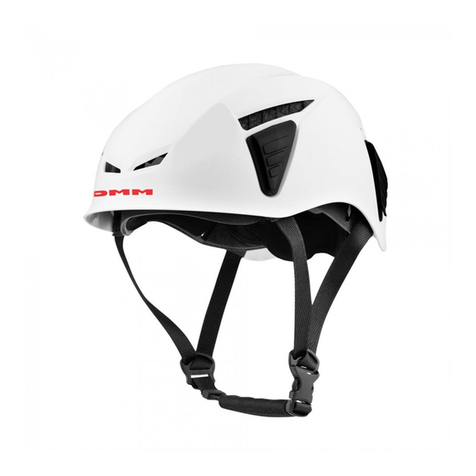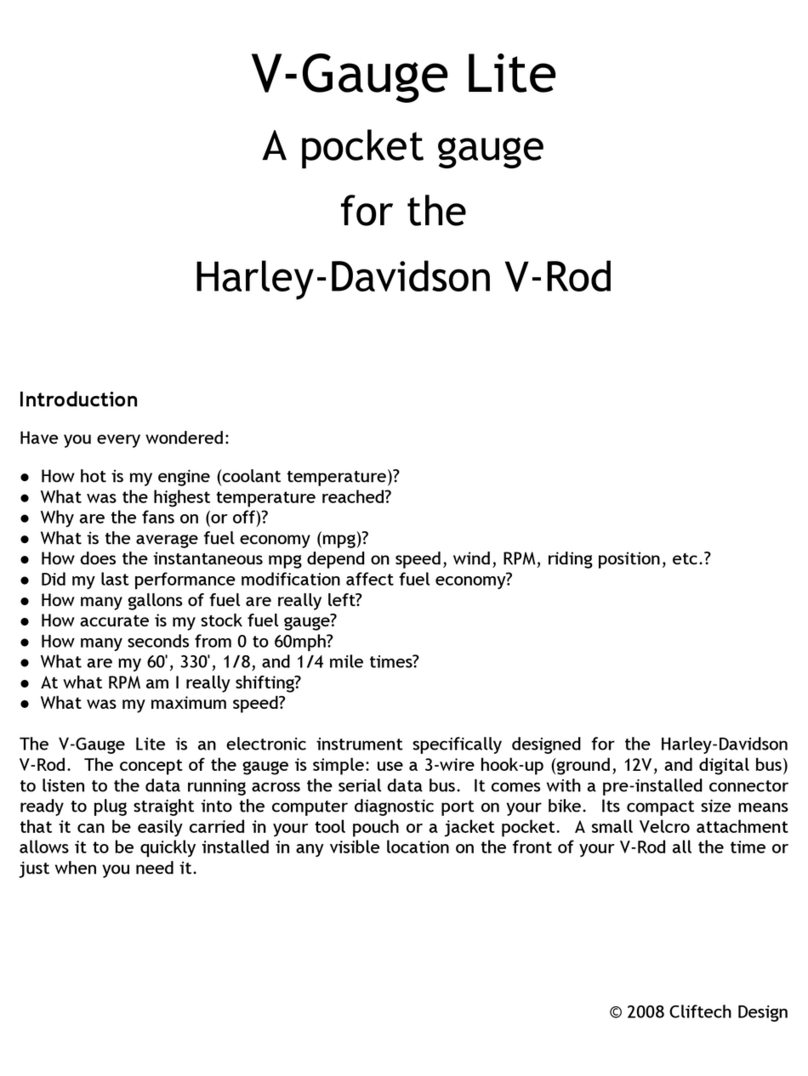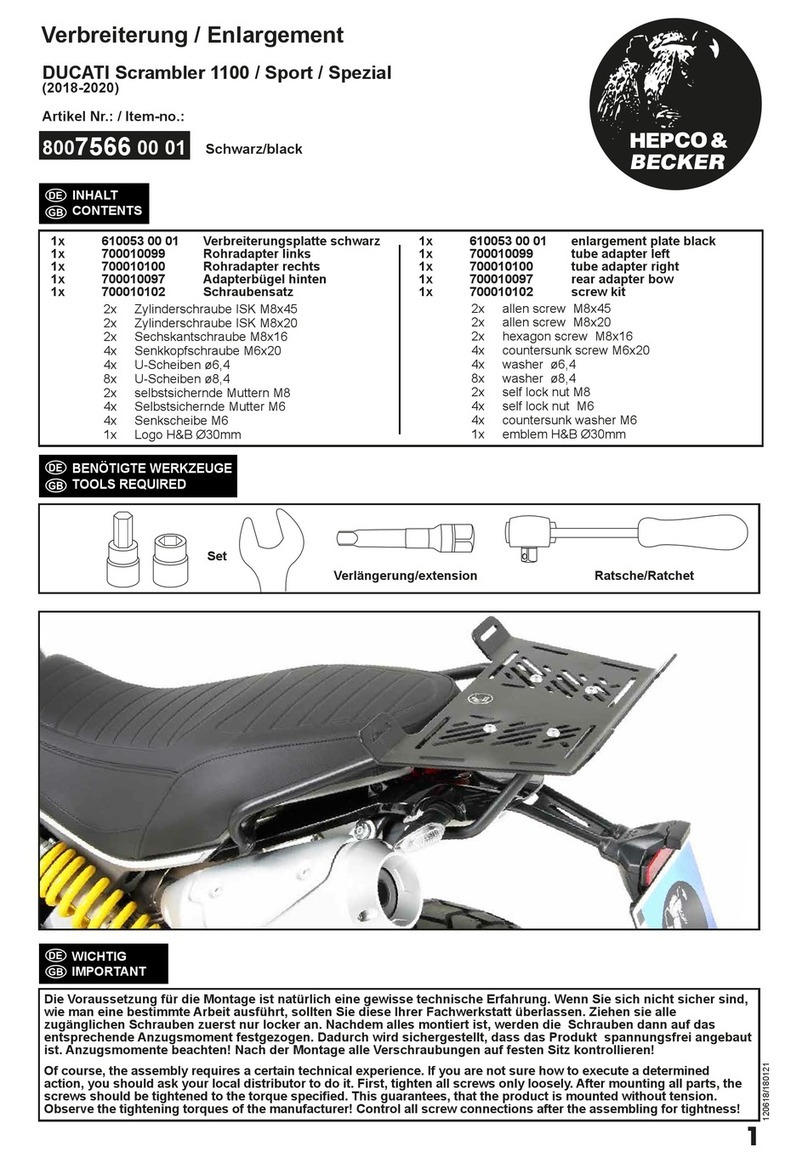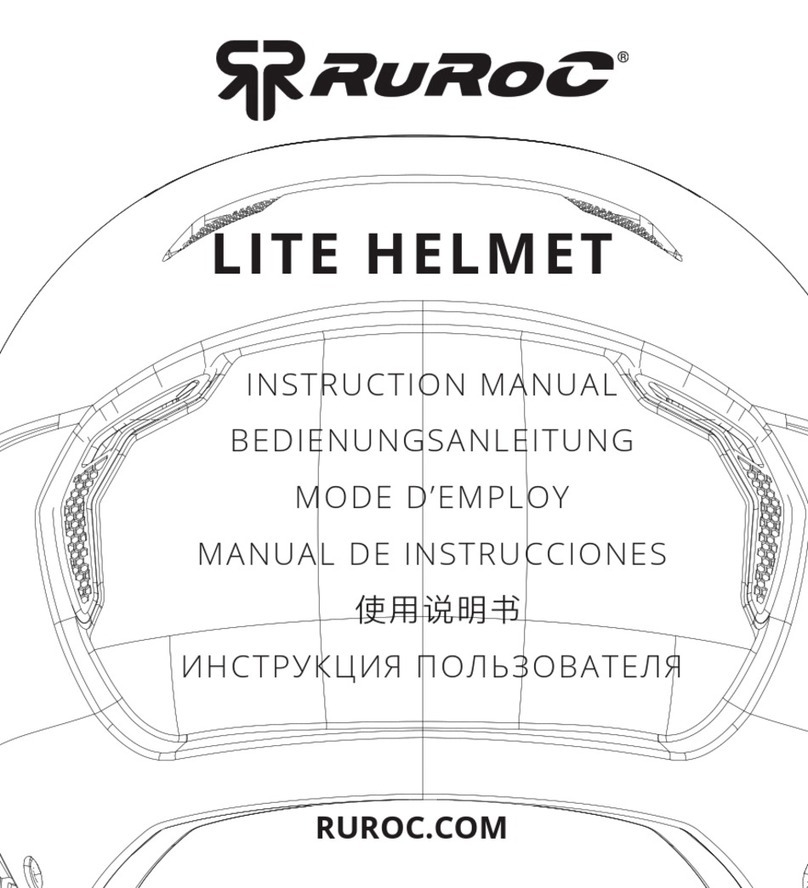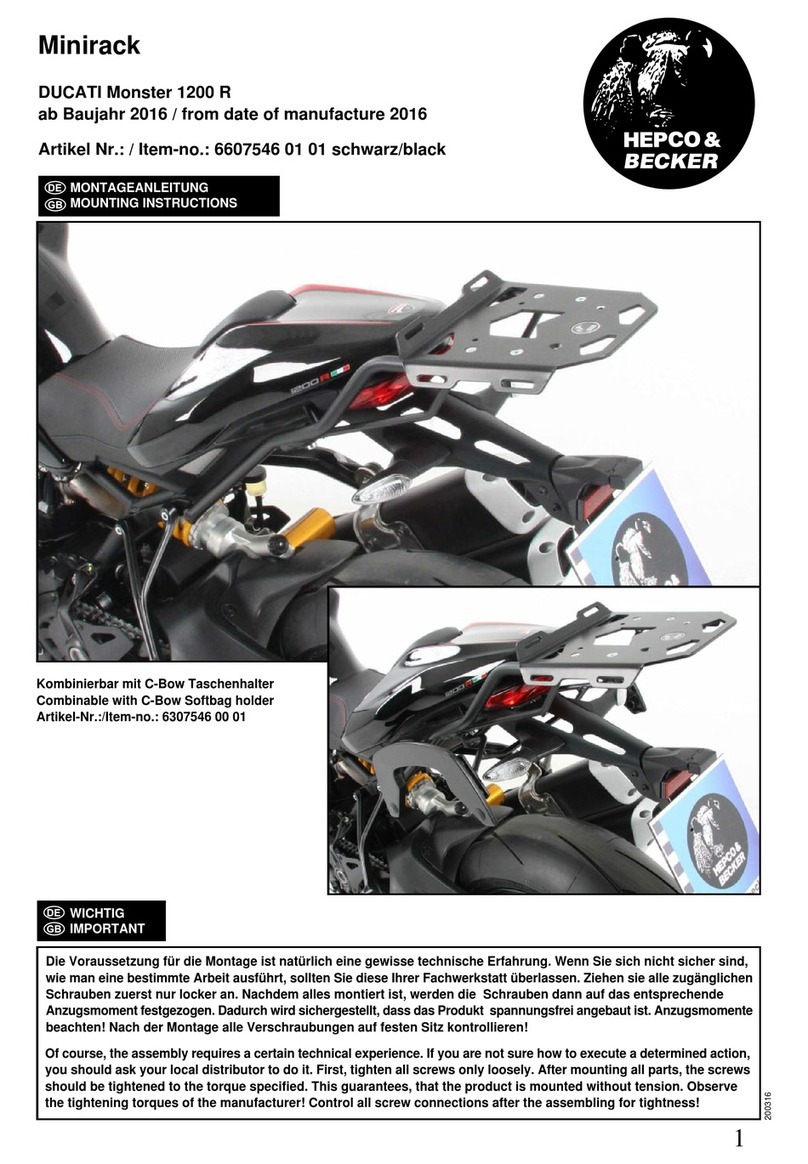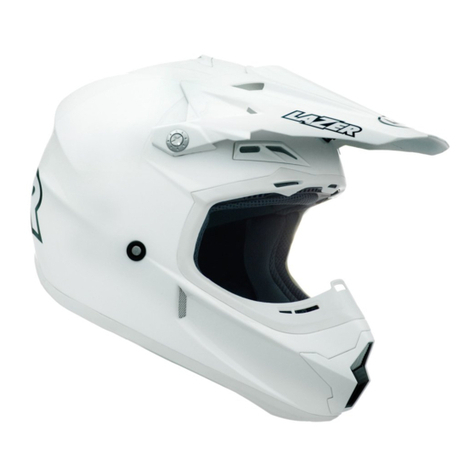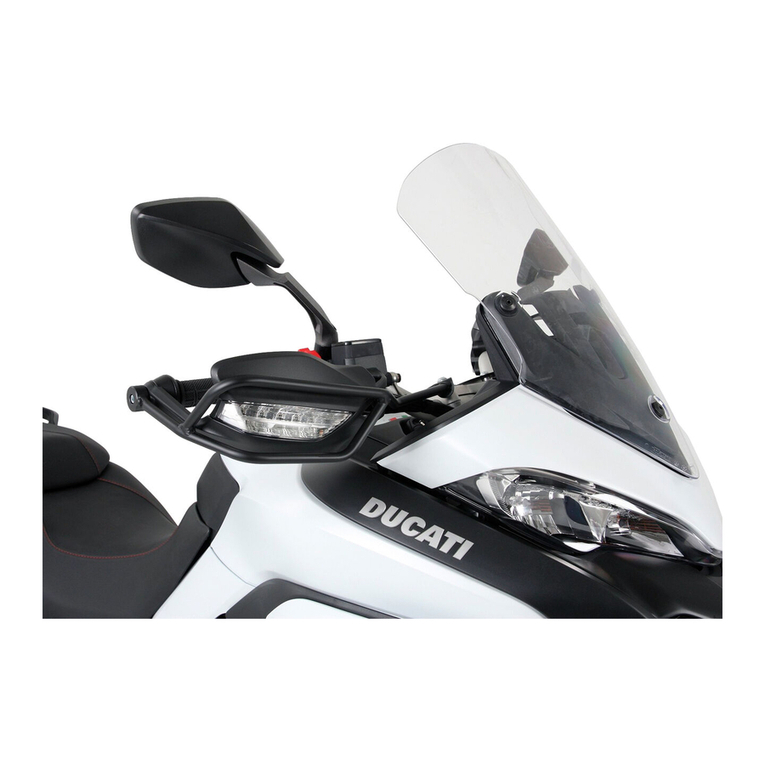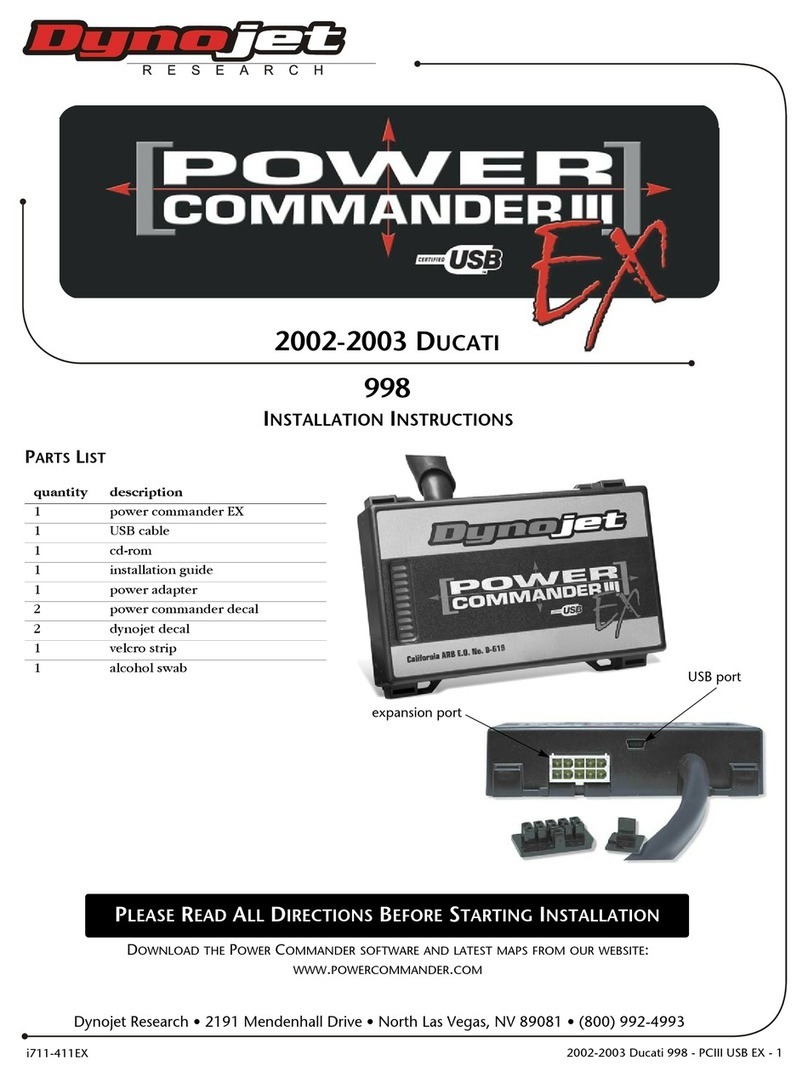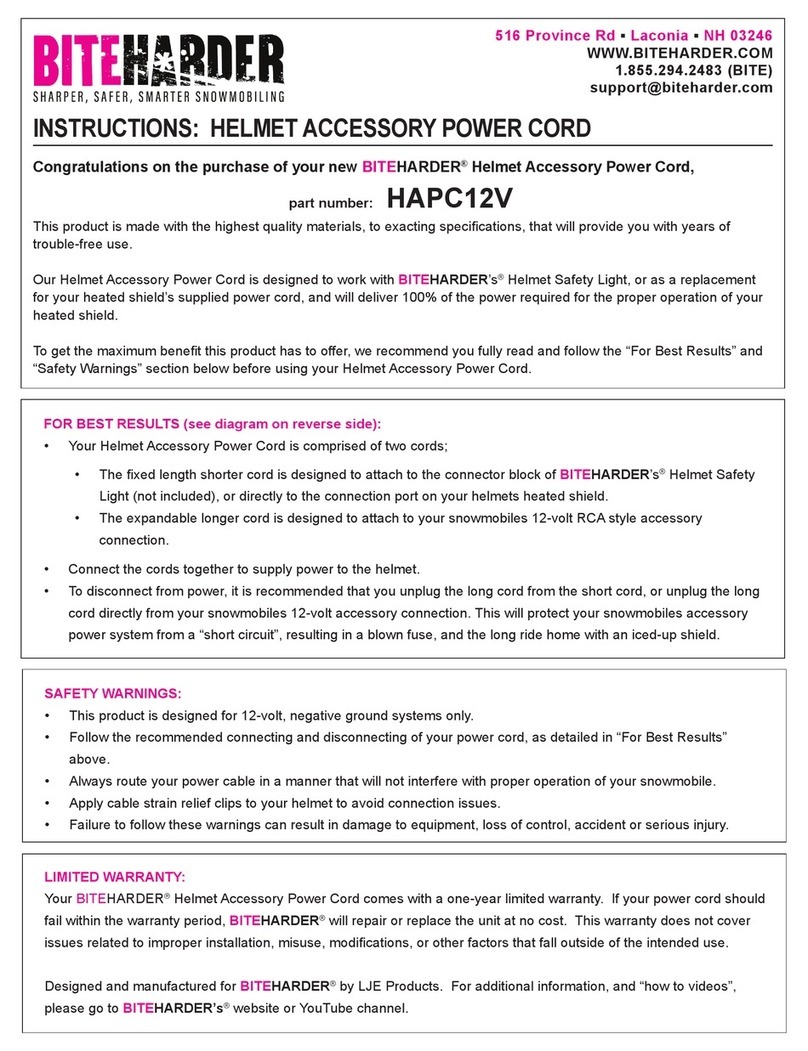Tecmen iMux Series User manual

Auto Darkening Welding Helmet
Owner’s Manual
Series ADF820SG iMUX (TM16)
* Designed to be used with Freflow V1 PAPR blower unit

Read & Understand All Instructions Before Using
WARNING
WARNING
WARNING
Severe personal injury could occur if the user fails to follow the above
mentioned warnings, and/or fails to follow the operating instructions.
SAFETY WARNINGS - READ BEFORE USING
1
The auto-darkening welding helmets are designed to protect the eye and face from sparks,
spatter and harmful radiation under normal welding conditions. This auto darkening filter
will automatically turn on when pick it up. The filter automatically changes from a light
state to a dark state when an arc is struck, and it returns to the light state when welding
stops. This helmet are designed to be used together with Freflow V1 blower unit to protect
against airborne contaminants.
The Auto-Darkening welding helmet comes assembled. But before it can be used, it must
be adjusted to fit the user properly. Check battery surfaces and contacts and clean it if
necessary. Verify if the battery is in good condition and installed properly. Set up for delay
time, sensitivity and shade number for your application.
The helmet should be stored in dry, cool and dark area and remove the battery, when not
using it for a long time.
Inspect face seal for damage and replace if necessary. Make sure the air is supplied to helmet.
This Auto-Darkening welding helmet is not suitable for laser welding.
Never place this helmet and Auto-Darkening filter on a hot surface.
Never open or tamper with the Auto-Darkening filter.
This Auto-Darkening welding helmet will not protect against severe impact hazards.
This helmet will not protect against explosive devices or corrosive liquids.
Do not make any modifications to either the filter or helmet, unless specified in this
manual. Do not use replacement parts other than those specified in this manual.
Unauthorized modifications and replacement parts will void the warranty and expose
the operator to the risk of personal injury.
Should this helmet not darken upon striking an arc, stop welding immediately and
contact your supervisor or your dealer.
Do not immerse the filter in water.
Do not use any solvents on the filter screen or helmet components.
Use only at temperatures: -10°C ~ +55°C (14°F ~ 131°F).
Storing temperature: -20°C ~ +70°C (- 4°F ~ 158°F). The helmet should be stored in dry
cool and dark area and remove the battery, when not using it for a long time.
Protect filter from contact with liquid and dirt.
Clean the filter surface regularly; do not use strong cleaning solutions. Always keep the
sensors and solar cells clean using a clean lint-free tissue.
Regularly replace the cracked / scratched / pitted front cover lens.
The materials which may come into contact with the wearer’s skin can cause allergic
reactions in some circumstances.
Professional Quality
Welding Helmet
•
•
•
•
•
•
•
•
•
•
•
•
•
•
•
•

• BATTERY INSTALLATION
When the indicator located on the lens starts to come
to red (See fig.2), it is a warning for the battery to be
replaced.
Slide the battery holder out of the auto darkening
filter, (remove the used battery when you replacing
battery), put new CR2450 batteries inside the battery
holder, be sure Positive (+) side of battery faces up
(See fig.1) and put the battery holder back into the
auto darkening filter.
•TEST
Before welding, press and hold "TEST" to preview
shade selection (See fig.2). When released then
viewingwindowwillautomaticallyreturntothelightstate(3.5Shade).Press"TEST",if
viewingwindowdoesnotturntodarkstate,replacebatteryandtryagain.
WARNING
The user must stop using the auto-darkening welding helmet immediately if
the above-mentioned problems cannot be corrected. Contact the dealer.
INSTRUCTIONS FOR USE
WARNING! Before using the helmet for welding, ensure that you have read and understood the safety instructions.
2
COMMON PROBLEMS AND REMEDIES
• Irregular Darkening Dimming
Headgear has been set unevenly and there is an uneven distance from the eyes to the
filter lens (Reset the headgear to reduce the difference to the filter).
• Auto-Darkening filter does not darken or flickers
①Front cover lens is soiled or damaged (Change the cover lens).
②Sensors are soiled (Clean the sensors surface).
③Welding current is too low (Adjust the sensitivity level to higher).
④Check battery and verify they are in good condition and installed properly. Also, check
battery surfaces and contacts and clean if necessary. Please refer to the “BATTERY
INSTALLATION” on page 2.
• Slow response
Operating temperature is too low (Do not use at temperatures below -10 °C or 14 °F).
• Poor vision
① Front / inside cover lens and / or the filter is soiled (Change lens).
② There is insufficient ambient light.
③Shade number is incorrectly set (Reset the shade number).
④ Check if removing the film on the front cover lens.
• Welding helmet slips
Headgear is not properly adjusted (Readjust the headgear).
• SELECTING SHADE LEVEL
Select the power shade number for your welding process by referring to the “Shade
Guide Table” on the last page. The shade can be adjusted from shade 5 to 8 and 9 to 13
based upon welding process or application. Shade is adjusted by setting the shade
range switch to the proper range (See fig.3), then turn the
shade control knob to the shade number required (See fig.4).
• SENSITIVITY
The sensitivity can be set to “ HI ” (high) or “ LO ” (low) by using
the infinitely dial knob on the back of the auto darkening filter.
The “Mid-High” setting is the normal setting for everyday use.
The maximum sensitivity level is appropriate for low welding
current work, TIG, or special applications. Higher sensitivity
setting is necessary if lens flashing on and off. Where the
operation of the helmet is disturbed by excess ambient light,
or another welding machine close by, use the “LO” setting (See
fig.4). As a simple rule, for optimum performance, it is
recommended to set sensitivity to the maximum at the
beginning and then gradually reduce it, until the filter reacts
only to the welding light flash and without annoying spurious
triggering due to ambient light conditions (direct sun,
intensive artificial light, neighbouring welder's arcs etc.).
• SELECTING DELAY TIME
When welding ceases, the viewing window automatically
changes from dark back to light but with a pre-set delay to
compensate for any bright afterglow on the workpiece. The
delay time / response can be set to “S” (short: 0.1 sec.) or “L”
(long: 1.0 sec.) as you require using the infinitely dial knob on
the back of the auto darkening filter (See fig.4). It is
recommended to use a shorter delay with spot welding
applications and a longer delay with applications using higher
currents. Longer delays can also be used for low current TIG
welding, and TIG / MIG / MAG pulse.
• SELECTING THE GRIND OPTION
After weld / cutting work, long press “GRIND” button on grind
control case for 2 seconds (See fig.5), the auto darkening filter
will switch to grind mode. Under this situation, the indicator
would turn green and flash every 3 seconds (See fig.2). Long
press “GRIND” button for 1 second again, it will return to the
previous mode.
• ADJUSTING THE FIT OF THE HELMET
The overall circumference of the headband can be made larger
or smaller by rotating the knob on the back of the headband. (See adjustment “Y” in
fig.6). This can be done while wearing the helmet and allows just the right tension to be
set to keep the helmet firmly on the head without it being too tight.
• If the headband is riding too high or too low on your head, adjust the strap which
passes over the top of your head. To do this release the end of the band by pushing the
locking pin out of the hole in the band. Slide the two portions of the band to a greater or
lesser width as required and push the locking pin through the nearest hole. (See
adjustment “W” in fig.6).
• Test the fit of the headband by lifting up and closing down the helmet a few times while
wearing it. If the headband moves while tilting, re-adjust it until it is stable.
• ADJUSTING THE DISTANCE BETWEEN THE HELMET AND THE FACE
Step 1: Undo the block nut (See “T” in fig.6) to adjust the distance between the helmet
and your face in the down position.
Step 2: Loosen the block nut on either side of the helmet and slide it nearer or further
from your face. (See adjustment “Z” in fig.6). It is important that your eyes are each the
same distance from the lens. Otherwise the darkening effect may appear uneven.
Step 3: Re-tighten the block nut when adjustment is complete.
• ADJUSTING VIEW ANGLE POSITION
TILT: Tilt adjustment is located on right side of helmet. Loosen the right headgear
tension knob and push the top end of the adjustment lever outward until the lever’s Stop
Tab clears the notches. Then rotate the lever forward or back to the desired tilt position.
The Stop will automatically engage again when released locking the helmet into position
(See fig.7).
• You are now ready to use the helmet. The shading may be adjusted during use by
re-setting the potentiometer control.
fig.1
SHADE 6-9 SHADE 9-13
TM Z87W4/6-9 / 9-13
CSA Z94.3 / COLTS
®
LABS
4/6-9 / 9-13 TECMEN 1/2/1/1 EN379 DIN
AS/NZS 1338.1
ADF820S

• BATTERY INSTALLATION
When the indicator located on the lens starts to come
to red (See fig.2), it is a warning for the battery to be
replaced.
Slide the battery holder out of the auto darkening
filter, (remove the used battery when you replacing
battery), put new CR2450 batteries inside the battery
holder, be sure Positive (+) side of battery faces up
(See fig.1) and put the battery holder back into the
auto darkening filter.
•TEST
Before welding, press and hold "TEST" to preview
shade selection (See fig.2). When released then
viewingwindowwillautomaticallyreturntothelightstate(3.5Shade).Press"TEST",if
viewingwindowdoesnotturntodarkstate,replacebatteryandtryagain.
3
• SELECTING SHADE LEVEL
Select the power shade number for your welding process by referring to the “Shade
Guide Table” on the last page. The shade can be adjusted from shade 5 to 8 and 9 to 13
based upon welding process or application. Shade is adjusted by setting the shade
range switch to the proper range (See fig.3), then turn the
shade control knob to the shade number required (See fig.4).
• SENSITIVITY
The sensitivity can be set to “ HI ” (high) or “ LO ” (low) by using
the infinitely dial knob on the back of the auto darkening filter.
The “Mid-High” setting is the normal setting for everyday use.
The maximum sensitivity level is appropriate for low welding
current work, TIG, or special applications. Higher sensitivity
setting is necessary if lens flashing on and off. Where the
operation of the helmet is disturbed by excess ambient light,
or another welding machine close by, use the “LO” setting (See
fig.4). As a simple rule, for optimum performance, it is
recommended to set sensitivity to the maximum at the
beginning and then gradually reduce it, until the filter reacts
only to the welding light flash and without annoying spurious
triggering due to ambient light conditions (direct sun,
intensive artificial light, neighbouring welder's arcs etc.).
• SELECTING DELAY TIME
When welding ceases, the viewing window automatically
changes from dark back to light but with a pre-set delay to
compensate for any bright afterglow on the workpiece. The
delay time / response can be set to “S” (short: 0.1 sec.) or “L”
(long: 1.0 sec.) as you require using the infinitely dial knob on
the back of the auto darkening filter (See fig.4). It is
recommended to use a shorter delay with spot welding
applications and a longer delay with applications using higher
currents. Longer delays can also be used for low current TIG
welding, and TIG / MIG / MAG pulse.
• SELECTING THE GRIND OPTION
After weld / cutting work, long press “GRIND” button on grind
control case for 2 seconds (See fig.5), the auto darkening filter
will switch to grind mode. Under this situation, the indicator
would turn green and flash every 3 seconds (See fig.2). Long
press “GRIND” button for 1 second again, it will return to the
previous mode.
• ADJUSTING THE FIT OF THE HELMET
The overall circumference of the headband can be made larger
or smaller by rotating the knob on the back of the headband. (See adjustment “Y” in
fig.6). This can be done while wearing the helmet and allows just the right tension to be
set to keep the helmet firmly on the head without it being too tight.
• If the headband is riding too high or too low on your head, adjust the strap which
passes over the top of your head. To do this release the end of the band by pushing the
locking pin out of the hole in the band. Slide the two portions of the band to a greater or
lesser width as required and push the locking pin through the nearest hole. (See
adjustment “W” in fig.6).
• Test the fit of the headband by lifting up and closing down the helmet a few times while
wearing it. If the headband moves while tilting, re-adjust it until it is stable.
• ADJUSTING THE DISTANCE BETWEEN THE HELMET AND THE FACE
Step 1: Undo the block nut (See “T” in fig.6) to adjust the distance between the helmet
and your face in the down position.
Step 2: Loosen the block nut on either side of the helmet and slide it nearer or further
from your face. (See adjustment “Z” in fig.6). It is important that your eyes are each the
same distance from the lens. Otherwise the darkening effect may appear uneven.
Step 3: Re-tighten the block nut when adjustment is complete.
• ADJUSTING VIEW ANGLE POSITION
TILT: Tilt adjustment is located on right side of helmet. Loosen the right headgear
tension knob and push the top end of the adjustment lever outward until the lever’s Stop
Tab clears the notches. Then rotate the lever forward or back to the desired tilt position.
The Stop will automatically engage again when released locking the helmet into position
(See fig.7).
• You are now ready to use the helmet. The shading may be adjusted during use by
re-setting the potentiometer control.
fig.4fig.2
fig.6
fig.5
fig.7
TiltAdjustment
Fore-Aft
Adjustment
fig.3
Red
Green
‘T’
‘T’
‘Z’‘Z’
TOP
TOP

• BATTERY INSTALLATION
When the indicator located on the lens starts to come
to red (See fig.2), it is a warning for the battery to be
replaced.
Slide the battery holder out of the auto darkening
filter, (remove the used battery when you replacing
battery), put new CR2450 batteries inside the battery
holder, be sure Positive (+) side of battery faces up
(See fig.1) and put the battery holder back into the
auto darkening filter.
•TEST
Before welding, press and hold "TEST" to preview
shade selection (See fig.2). When released then
viewingwindowwillautomaticallyreturntothelightstate(3.5Shade).Press"TEST",if
viewingwindowdoesnotturntodarkstate,replacebatteryandtryagain.
4
• SELECTING SHADE LEVEL
Select the power shade number for your welding process by referring to the “Shade
Guide Table” on the last page. The shade can be adjusted from shade 5 to 8 and 9 to 13
based upon welding process or application. Shade is adjusted by setting the shade
range switch to the proper range (See fig.3), then turn the
shade control knob to the shade number required (See fig.4).
• SENSITIVITY
The sensitivity can be set to “ HI ” (high) or “ LO ” (low) by using
the infinitely dial knob on the back of the auto darkening filter.
The “Mid-High” setting is the normal setting for everyday use.
The maximum sensitivity level is appropriate for low welding
current work, TIG, or special applications. Higher sensitivity
setting is necessary if lens flashing on and off. Where the
operation of the helmet is disturbed by excess ambient light,
or another welding machine close by, use the “LO” setting (See
fig.4). As a simple rule, for optimum performance, it is
recommended to set sensitivity to the maximum at the
beginning and then gradually reduce it, until the filter reacts
only to the welding light flash and without annoying spurious
triggering due to ambient light conditions (direct sun,
intensive artificial light, neighbouring welder's arcs etc.).
• SELECTING DELAY TIME
When welding ceases, the viewing window automatically
changes from dark back to light but with a pre-set delay to
compensate for any bright afterglow on the workpiece. The
delay time / response can be set to “S” (short: 0.1 sec.) or “L”
(long: 1.0 sec.) as you require using the infinitely dial knob on
the back of the auto darkening filter (See fig.4). It is
recommended to use a shorter delay with spot welding
applications and a longer delay with applications using higher
currents. Longer delays can also be used for low current TIG
welding, and TIG / MIG / MAG pulse.
• SELECTING THE GRIND OPTION
After weld / cutting work, long press “GRIND” button on grind
control case for 2 seconds (See fig.5), the auto darkening filter
will switch to grind mode. Under this situation, the indicator
would turn green and flash every 3 seconds (See fig.2). Long
press “GRIND” button for 1 second again, it will return to the
previous mode.
• ADJUSTING THE FIT OF THE HELMET
The overall circumference of the headband can be made larger
or smaller by rotating the knob on the back of the headband. (See adjustment “Y” in
fig.6). This can be done while wearing the helmet and allows just the right tension to be
set to keep the helmet firmly on the head without it being too tight.
• If the headband is riding too high or too low on your head, adjust the strap which
passes over the top of your head. To do this release the end of the band by pushing the
locking pin out of the hole in the band. Slide the two portions of the band to a greater or
lesser width as required and push the locking pin through the nearest hole. (See
adjustment “W” in fig.6).
• Test the fit of the headband by lifting up and closing down the helmet a few times while
wearing it. If the headband moves while tilting, re-adjust it until it is stable.
• ADJUSTING THE DISTANCE BETWEEN THE HELMET AND THE FACE
Step 1: Undo the block nut (See “T” in fig.6) to adjust the distance between the helmet
and your face in the down position.
Step 2: Loosen the block nut on either side of the helmet and slide it nearer or further
from your face. (See adjustment “Z” in fig.6). It is important that your eyes are each the
same distance from the lens. Otherwise the darkening effect may appear uneven.
Step 3: Re-tighten the block nut when adjustment is complete.
• ADJUSTING VIEW ANGLE POSITION
TILT: Tilt adjustment is located on right side of helmet. Loosen the right headgear
tension knob and push the top end of the adjustment lever outward until the lever’s Stop
Tab clears the notches. Then rotate the lever forward or back to the desired tilt position.
The Stop will automatically engage again when released locking the helmet into position
(See fig.7).
• You are now ready to use the helmet. The shading may be adjusted during use by
re-setting the potentiometer control.
• REPLACING FRONT COVER LENS
Replace the front cover lens if it is damaged. Remove filter holder assembly (See fig.9).
Remove front cover lens from helmet assembly. Carefully remove gasket from cover
lens. Install new cover lens into gasket and assemble to helmet shell. Make sure to
assemble cover lens and gasket into helmet shell the same way as it was removed.
• REPLACING INSIDE COVER LENS
Replace the inside clear lens if it is damaged. Place your fingernail in recess below view
window and flex lens upwards until it releases from edges of view window.
• REPLACING THE AUTO DARKENING FILTER
First, pull out plug of wire from grind control case (See fig.8). Second, take out wire from
hole in the helmet window and remove filter holder assembly from helmet (See fig.9).
Third, flex top end of holder to remove filter and revolve plug carefully from the hole in
holder (See fig.10). When installing new filter, first, put wire through the hole in holder
and make sure that filter is installed in holder correctly. Second, put wire through the
hole in helmet window and install holder assembly into helmet shell. Third, insert plug of
wire into grind control case.
MAINTENANCE

• BATTERY INSTALLATION
When the indicator located on the lens starts to come
to red (See fig.2), it is a warning for the battery to be
replaced.
Slide the battery holder out of the auto darkening
filter, (remove the used battery when you replacing
battery), put new CR2450 batteries inside the battery
holder, be sure Positive (+) side of battery faces up
(See fig.1) and put the battery holder back into the
auto darkening filter.
•TEST
Before welding, press and hold "TEST" to preview
shade selection (See fig.2). When released then
viewingwindowwillautomaticallyreturntothelightstate(3.5Shade).Press"TEST",if
viewingwindowdoesnotturntodarkstate,replacebatteryandtryagain.
5
• SELECTING SHADE LEVEL
Select the power shade number for your welding process by referring to the “Shade
Guide Table” on the last page. The shade can be adjusted from shade 5 to 8 and 9 to 13
based upon welding process or application. Shade is adjusted by setting the shade
range switch to the proper range (See fig.3), then turn the
shade control knob to the shade number required (See fig.4).
• SENSITIVITY
The sensitivity can be set to “ HI ” (high) or “ LO ” (low) by using
the infinitely dial knob on the back of the auto darkening filter.
The “Mid-High” setting is the normal setting for everyday use.
The maximum sensitivity level is appropriate for low welding
current work, TIG, or special applications. Higher sensitivity
setting is necessary if lens flashing on and off. Where the
operation of the helmet is disturbed by excess ambient light,
or another welding machine close by, use the “LO” setting (See
fig.4). As a simple rule, for optimum performance, it is
recommended to set sensitivity to the maximum at the
beginning and then gradually reduce it, until the filter reacts
only to the welding light flash and without annoying spurious
triggering due to ambient light conditions (direct sun,
intensive artificial light, neighbouring welder's arcs etc.).
• SELECTING DELAY TIME
When welding ceases, the viewing window automatically
changes from dark back to light but with a pre-set delay to
compensate for any bright afterglow on the workpiece. The
delay time / response can be set to “S” (short: 0.1 sec.) or “L”
(long: 1.0 sec.) as you require using the infinitely dial knob on
the back of the auto darkening filter (See fig.4). It is
recommended to use a shorter delay with spot welding
applications and a longer delay with applications using higher
currents. Longer delays can also be used for low current TIG
welding, and TIG / MIG / MAG pulse.
• SELECTING THE GRIND OPTION
After weld / cutting work, long press “GRIND” button on grind
control case for 2 seconds (See fig.5), the auto darkening filter
will switch to grind mode. Under this situation, the indicator
would turn green and flash every 3 seconds (See fig.2). Long
press “GRIND” button for 1 second again, it will return to the
previous mode.
• ADJUSTING THE FIT OF THE HELMET
The overall circumference of the headband can be made larger
or smaller by rotating the knob on the back of the headband. (See adjustment “Y” in
fig.6). This can be done while wearing the helmet and allows just the right tension to be
set to keep the helmet firmly on the head without it being too tight.
• If the headband is riding too high or too low on your head, adjust the strap which
passes over the top of your head. To do this release the end of the band by pushing the
locking pin out of the hole in the band. Slide the two portions of the band to a greater or
lesser width as required and push the locking pin through the nearest hole. (See
adjustment “W” in fig.6).
• Test the fit of the headband by lifting up and closing down the helmet a few times while
wearing it. If the headband moves while tilting, re-adjust it until it is stable.
• ADJUSTING THE DISTANCE BETWEEN THE HELMET AND THE FACE
Step 1: Undo the block nut (See “T” in fig.6) to adjust the distance between the helmet
and your face in the down position.
Step 2: Loosen the block nut on either side of the helmet and slide it nearer or further
from your face. (See adjustment “Z” in fig.6). It is important that your eyes are each the
same distance from the lens. Otherwise the darkening effect may appear uneven.
Step 3: Re-tighten the block nut when adjustment is complete.
• ADJUSTING VIEW ANGLE POSITION
TILT: Tilt adjustment is located on right side of helmet. Loosen the right headgear
tension knob and push the top end of the adjustment lever outward until the lever’s Stop
Tab clears the notches. Then rotate the lever forward or back to the desired tilt position.
The Stop will automatically engage again when released locking the helmet into position
(See fig.7).
• You are now ready to use the helmet. The shading may be adjusted during use by
re-setting the potentiometer control.
1 / 1 / 1 / 1
95 x 85 mm (3.74" x 3.35")
133 x 114 x 9 mm (5.25" x 4.50" x 0.35")
4
DIN 3.5
Variable Shade 5 ~ 8 / 9 ~ 13
Internal, Variable Shade
Automatic On / Off
Low — High, by infinitely dial knob
Up to Shade DIN16 at all times
Solar cell. Battery replaceable,
1 x CR2450 lithium battery
1/25,000 s. from Light to Dark
0.1 ~ 1.0 s by infinitely dial knob
≥ 2 amps (DC); ≥ 2 amps (AC)
Yes
Yes
-10 °C ~ +55 °C (14 °F ~ 131 °F)
-20 °C ~ +70 °C (- 4 °F ~ 158 °F)
High Impact Resistance Nylon
Stick Welding (SMAW); TIG DC∾ TIG Pulse DC;
TIG Pulse AC; MIG/MAG/CO2; MIG/MAG Pulse;
Plasma Arc Cutting (PAC); Plasma Arc Welding (PAW);
Air Carbon Arc Cutting (CAC-A); Oxyfuel Gas Welding
(OFW); Oxygen Cutting (OC); Grinding
DINplus, CE, ANSI Z87.1, CSA Z94.3, AS/NZS 1338.1
Optical Class:
Viewing Area:
Cartridge Size:
Arc Sensor:
Light State:
Dark State:
Shade Control:
Power On/Off:
Sensitivity Control:
UV/IR Protection:
Power Supply:
Switching Time:
Delay (Dark to Light):
Low Amperage TIG Rated:
Grinding:
Battery Capacity Test:
Operating Temp.:
Storing Temp.:
Helmet Material:
Application Range:
Approved:
fig.10
fig.9
fig.8
• CLEANING
Clean helmet by wiping with a soft cloth. Clean auto darkening filter surfaces regularly.
Do not use strong cleaning solutions. Clean sensors and solar cells with methylated
spirit and a clean cloth and wipe dry with a lint-free cloth.
• FACE SEAL
The face seal can be used to facilitate cleaning after disassembling from the shell, but it
must be replaced if it is damaged.
TECHNICAL SPECIFICATIONS

6
PARTS LIST & ASSEMBLY
21
Face seal
Headgear (Including plenum, sweatband & soft pad)
Sweatband
Soft pad
Helmet shell
Rubber frame
Outside cover lens (133×114 mm)
Auto darkening filter
Inside cover lens (94.7 x 89.7 mm)
Lens holder
V1FS TM16 00
V1HG TM16 00
V1SW TM3 00
V1SP TM3 00
V1PH TM16 01
RF TM11 01
FC TM05 01
ADF820SG iMUX
IC TM820S 01
HD TM16 02
A-1
A-2
A-3
A-4
A-5
A-6
A-7
A-8
A-9
A-10
ITEM PART NO. DESCRIPTION
3 4
5 6 7 8 9 10

SHADE GUIDE TABLE
Shielded metal arc
welding
Gas metal arc
welding and flux
cored arc welding
Gas tungsten arc
welding
Air carbon
Arc cutting
Plasma arc welding
Plasma arc cutting
Torch brazing
Torch soldering
Carbon arc welding
Gas welding
Light
Medium
Heavy
Oxygen cutting
Light
Medium
Heavy
Less than 3 (2.5)
3-5 (2.5–4)
5-8 (4–6.4)
More than 8 (6.4)
(Light)
(Heavy)
(Light)(2)
(Medium)(2)
(Heavy)(2)
Under 1/8
1/8 to 1/2
Over 1/2
Under 1
1 to 6
Over 6
Less than 60
60-160
160-250
250-550
Less than 60
60-160
160-250
250-500
Less than 50
50-150
150-500
Less than 500
500-1000
Less than 20
20-100
100-400
400-800
Less than 300
300-400
400-800
–
–
–
Under 3.2
3.2 to 12.7
Over 12.7
Under 25
25 to 150
Over 150
—
10
12
14
—
11
12
14
10
12
14
12
14
6 to 8
10
12
14
8
12
14
3 to 4
2
14
4 or 5
5 or 6
6 or 8
3 or 4
4 or 5
5 or 6
7
8
10
11
7
10
10
10
8
8
10
10
11
6
8
10
11
8
9
10
–
–
–
GUIDE FOR SHADE NUMBERS
OPERATION ELECTRODE SIZE
1/32 in. (mm)
ARC
CURRENT(A)
MINIMUM
PROTECTIVW
SHADE
SUGGRSTED(1)
SHADE NO.
(COMFORT)
(1) As a rule of thumb, start with a shade that is too dark, then go to a lighter shade which gives sufficient view of the weld zone without going below
the minimum. In oxyfuel gas welding or cutting where the torch produces a high yellow light, it is desirable to use a filter lens that absorbs the yellow
or sodium line the visible light of the (spectrum) operation.
(2) These values apply where the actual arc is clearly seen. Experience has shown that lighter filters may be used when the arc is hidden by the
workpiece.
Data from ANSI Z49.1-2005
PLATE THICKNESS
in. mm
This manual suits for next models
1
Table of contents
Popular Motorcycle Accessories manuals by other brands
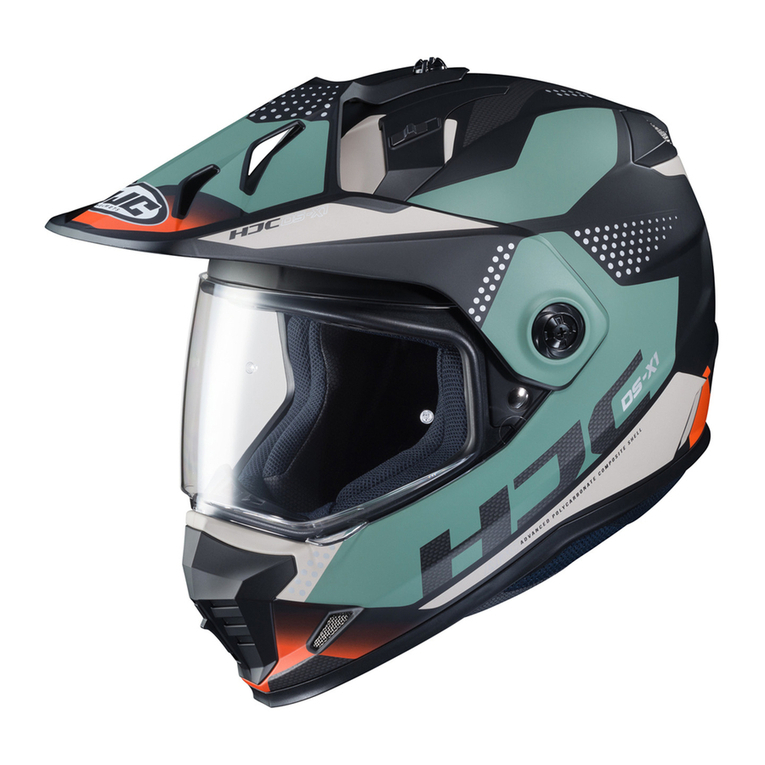
HJC
HJC DS-X1 user manual
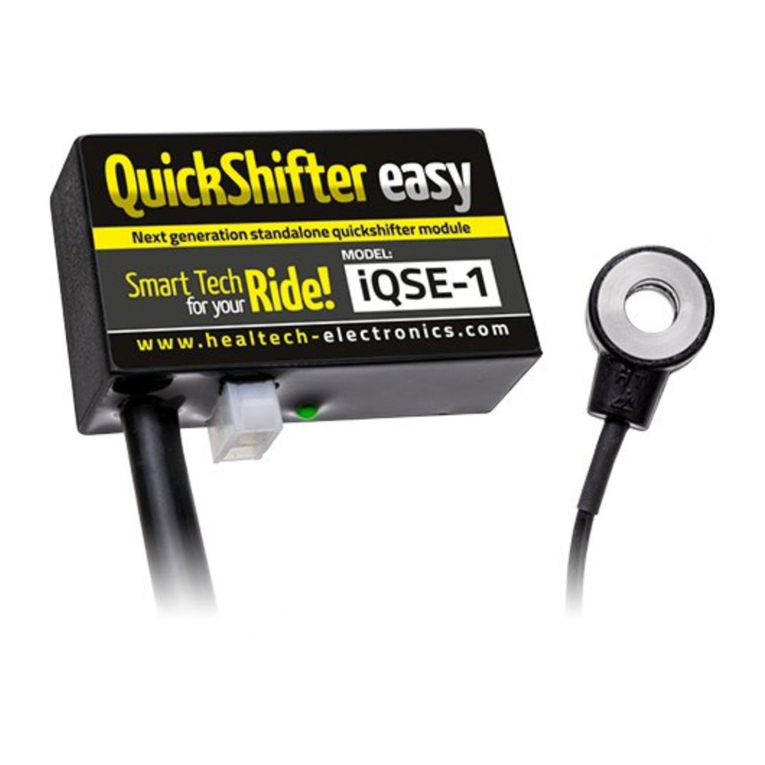
HealTech Electronics
HealTech Electronics Kawasaki W800 2011 Supplementary manual
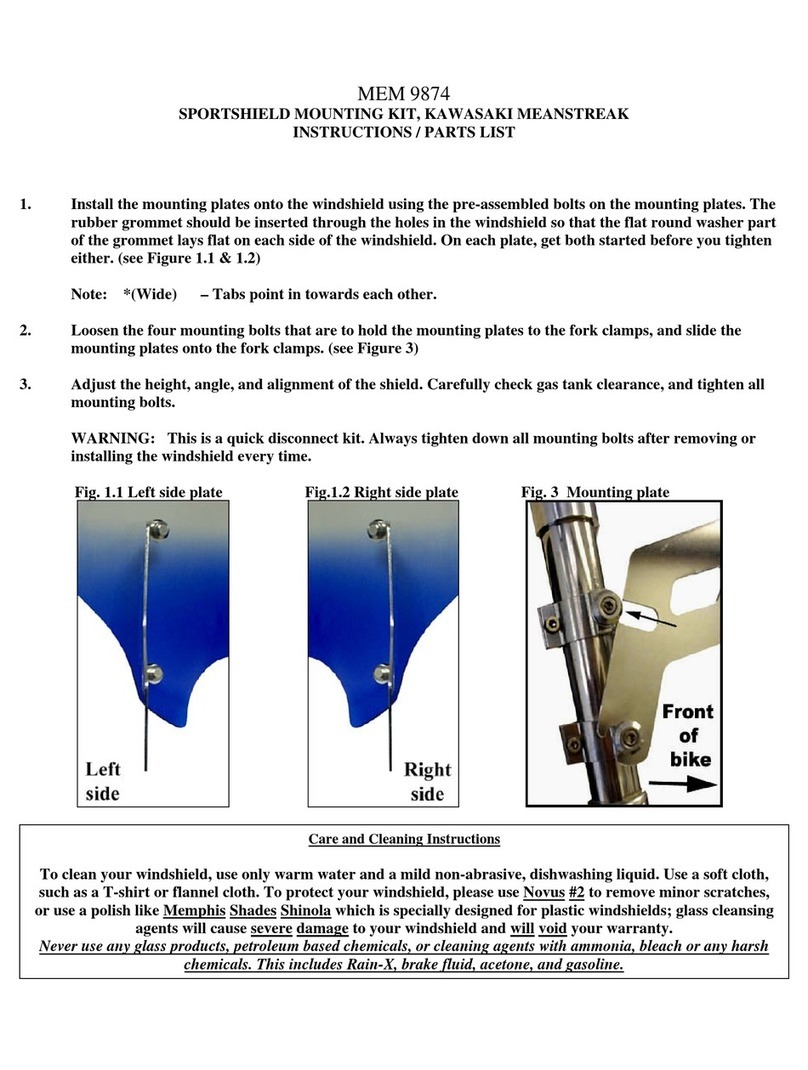
Memphis Shades
Memphis Shades 9874 Instructions and parts list

hepco & becker
hepco & becker 6307596 00 01 manual
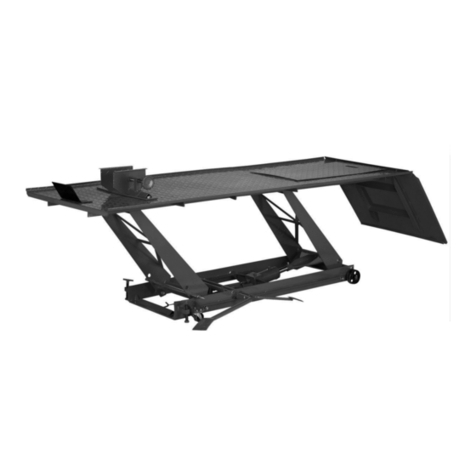
Central Hydraulics
Central Hydraulics 91764 Set up and operating instructions
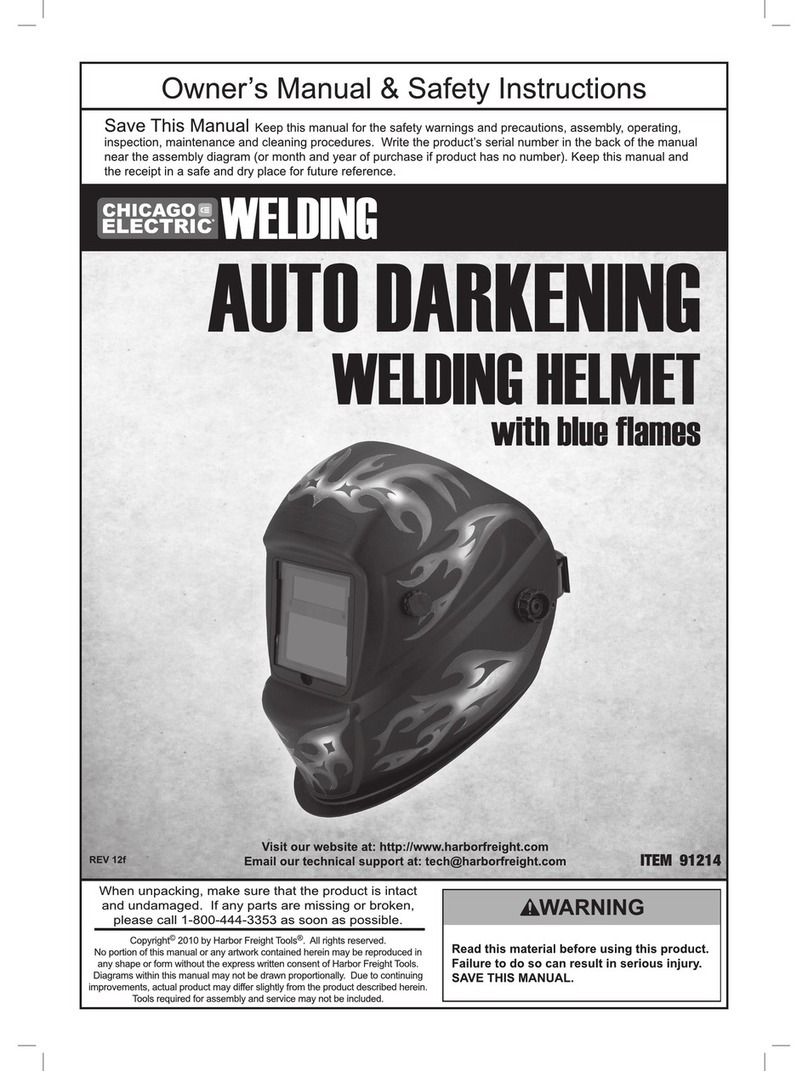
Chicago Electric
Chicago Electric 91214 Owner's manual & safety instructions


